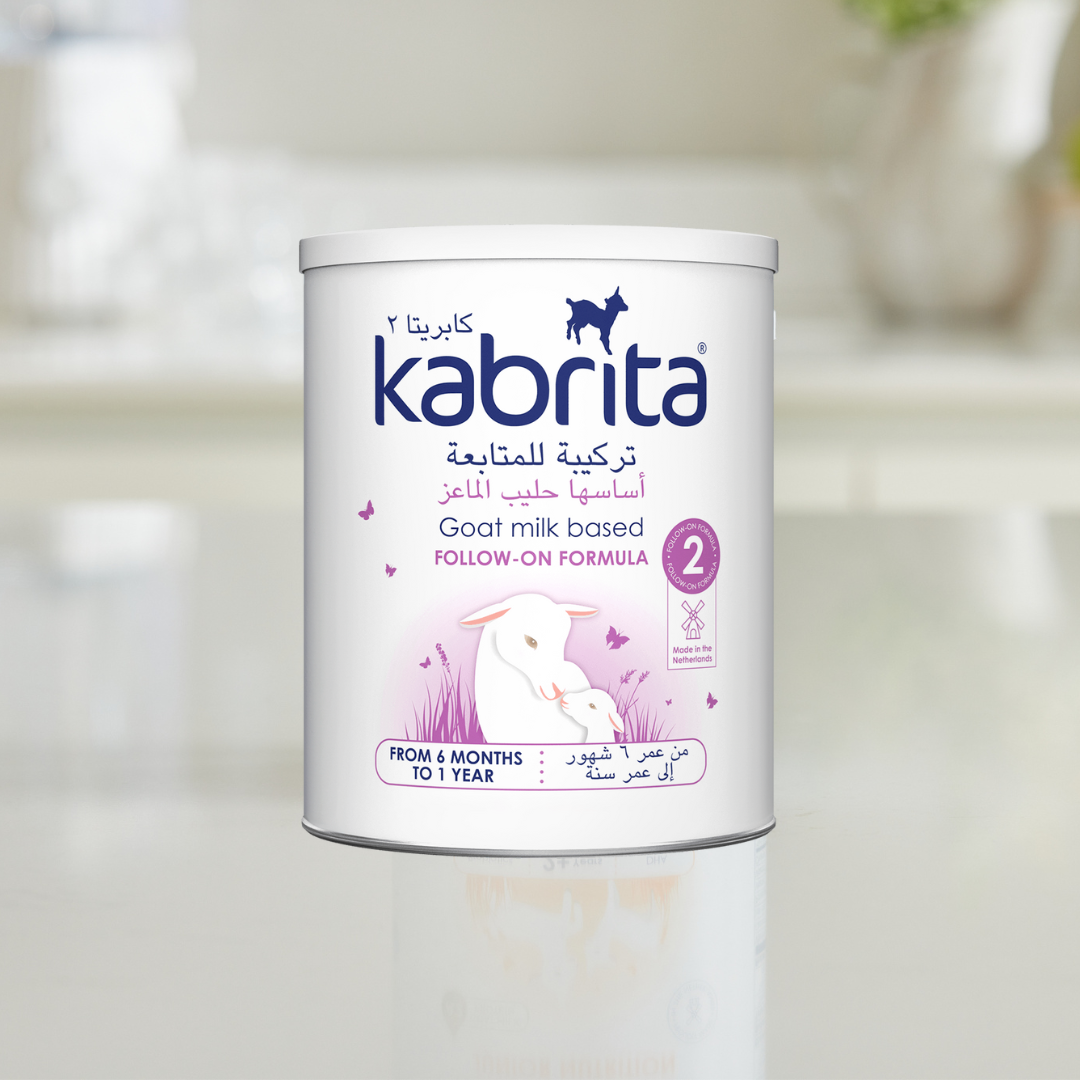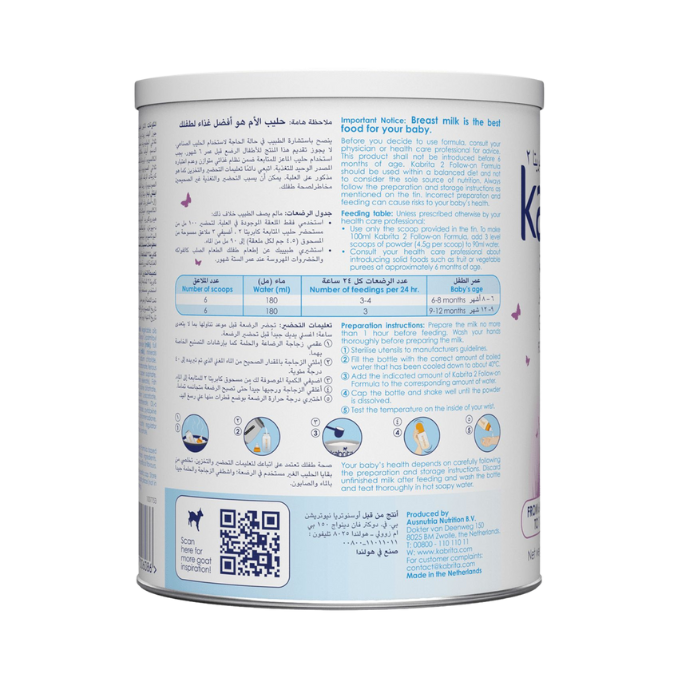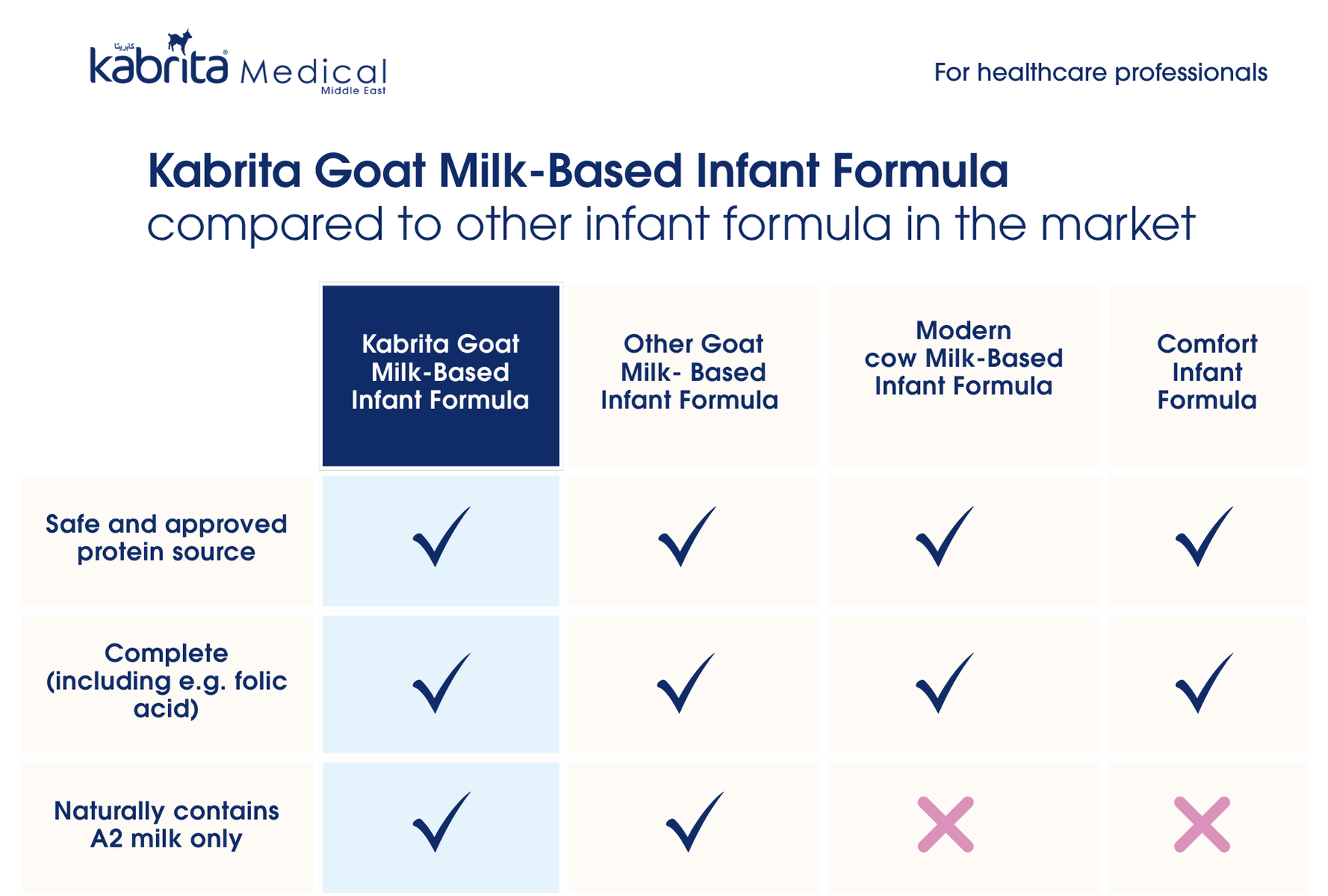
Goat Milk-Based Follow-On Formula
Kabrita Goat milk-based follow-on formula is suitable for infants from 6-12 months of age and is part of a balanced diet.



.png?width=1024&height=1024&name=Kabrita-Medical-Tin-S2-for-web-page%20(1).png)
What's inside
Goat milk protein
Easier to digest than cow milk protein
Lactose
Lactose is the only sugar in Kabrita. It has moderate glycemic index and it provides the body with galactose which is crucial for brain development
Oligosaccharides
Goat milk naturally has 6x more prebiotics than cow milk8,18
Rich in sn-2 palmitic acid
Similar to breast milk13; Ca+ & fat absorption14, 15 and stool consistency16,17
12.8mcg/100ml meets US and EU requirements
ARA & DHA
> 1:1 ratio to meet scientific recommendations



Review the label
Disclaimer: This recipe and label are specific to the ME formulation.



Ingredient deep dive
Click on each ingredient to learn what it is and why we’re proud to have it in our formulaLactose is the main carbohydrate in goat milk, and carbohydrates are essential for childhood growth and development.
Lactose also has prebiotic properties and enhances the absorption of calcium and magnesium,22 and may support gut health by increasing the growth of beneficial bacteria.23
Skimmed goat milk is the base for all Kabrita products and provides both carbohydrates and protein, both essential for healthy growth and development in infants and children.
The carbohydrates are in the form of lactose, while the two major constituents of milk protein are whey and casein.4
Fats are crucial for healthy growth and development. No single plant-based oil has a comparable fatty acid profile to that of breast milk, so all infant formulas contain an oil blend. Our oil blend includes coconut oil to deliver a fatty acid profile that resembles the fatty acid profile in human milk as close as possible.
Other benefits including better stool consistency, reduced crying time, and a well-balanced gut microbiota have been reported in scientific research.17,25–29
Galacto-oligosaccharides (GOS) are complex carbohydrates that are also naturally found in human milk.
GOS is the most studied prebiotic and has proven health benefits such as the ability to stimulate growth of beneficial bacteria, hamper the growth of pathogenic bacteria, and improve stool consistency.30
Calcium makes up much of the structure of bones and teeth and allows normal bodily movement by keeping tissue rigid, strong, and flexible.
A small ionized pool of calcium in the circulatory system, extracellular fluid, and various tissues mediates blood vessel contraction and dilation, muscle function, blood clotting, nerve transmission, and hormonal secretion.42
Potassium has a strong relationship with sodium, the main regulator of extracellular fluid volume, including plasma volume.43
Zinc also supports healthy growth and development during infancy, childhood, and adolescence and is involved in the sense of taste.51
Copper is a cofactor for several enzymes involved in energy production, iron metabolism, neuropeptide activation, connective tissue synthesis, and neurotransmitter synthesis.
Copper is also involved in many physiologic processes, such as angiogenesis; neurohormone homeostasis; and regulation of gene expression, brain development, pigmentation, and immune system functioning.
Copper also helps the body defend against oxidative damage.57
Manganese is involved in amino acid, cholesterol, glucose, and carbohydrate metabolism; reactive oxygen species scavenging; bone formation; reproduction; and immune response.
Manganese also plays a role in blood clotting and hemostasis in conjunction with vitamin K.56
Iodine is an essential component of the thyroid hormones that regulate many important biochemical reactions, including protein synthesis and enzymatic activity, and are critical determinants of metabolic activity.
They are also required for proper skeletal and central nervous system development in fetuses and infants.61
Since 2020, the European infant formula regulations require DHA to be added to infant formula, although it’s not mandatory in the United States.39
Along with ARA, DHA is crucial for brain, eye, and neurological development.32,35
Together with DHA, ARA supports normal eye, brain, and neurological development as well as the repair and growth of muscle tissue.32–35
The balance between DHA and ARA is important, and Kabrita formula meets the scientific recommendation of more ARA than DHA.31,34,36,37
Vitamin C is also an important physiological antioxidant and has been shown to regenerate other antioxidants within the body, including alpha-tocopherol. It plays an important role in immune function and improves the absorption of nonheme iron.44
Vitamin C is also an important physiological antioxidant and has been shown to regenerate other antioxidants within the body, including alpha-tocopherol. It plays an important role in immune function and improves the absorption of nonheme iron.44
Riboflavin also helps maintain normal levels of homocysteine, an amino acid in the blood.55
Vitamin A is a fat-soluble vitamin that is involved in immune function, cellular communication, growth and development, and male and female reproduction.
Vitamin A supports cell growth and differentiation, playing a critical role in the normal formation and maintenance of the heart, lungs, eyes, and other organs.53
Vitamin D is a fat-soluble vitamin that promotes calcium absorption in the gut and is critical for normal bone mineralization, bone growth, and bone remodeling.
Vitamin D has other roles in the body, including reduction of inflammation as well as modulation of such processes as cell growth, neuromuscular and immune function, and glucose metabolism.
Many genes encoding proteins that regulate cell proliferation, differentiation, and apoptosis are modulated in part by vitamin D.64
Potassium is required for normal cell function because of its role in maintaining intracellular fluid volume and transmembrane electrochemical gradients.
Potassium has a strong relationship with sodium, the main regulator of extracellular fluid volume, including plasma volume.43
Follow-on formula product resources

Follow-On Formula Product Guide
Learn what makes Kabrita an ideal infant formula for babies with our 2-page resource. Discover the e...

Infant Formula Comparison Chart
Stay informed and support confident decision-making with this in-depth infant formula comparison cha...







